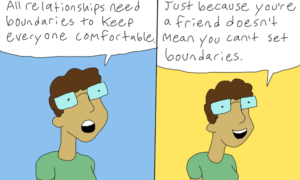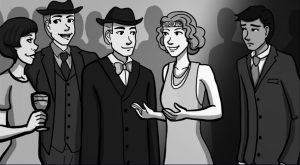
Source: Scholastic
I started censoring myself in the seventh grade.
The kids in my class made fun of me for using too many “big words” and getting too many Bible trivia questions right in my Catechism class, so I learned to stop.
Being “too smart” can lead to teasing for any kid, but certain demographics get unique torment – especially in a small parochial school with 18 kids in your entire grade – and young girls certainly have their own set of obstacles.
And it’s not just teasing that made me start to dumb down at a young age. There is a whole set of cultural forces and historically rooted patriarchal rhetoric that aims to deter females from trusting their brains and voices.
Here are just a few examples of how girls are taught to avoid “smart.”
1. Pretty vs. Smart
There’s this notion — circulated by pop culture — that pretty girls can’t be smart.
A classic example is the dichotomization of the two main female characters in Scooby-Doo, Daphne and Velma. Daphne is thin, passive, and attractive to the male characters. Velma is awkward, smart, and not sexualized.
Velma is often the butt of jokes (in the newer version of the cartoon, she makes mention of humorously androgynous features such as having a “lady ‘stache”), and while she almost always solves the mystery, her intelligence is generally unappreciated.
Over and over again, we see the show send the message that being a Daphne is far preferable to being a Velma.
And yes, we have seen some progress with the pretty/smart dichotomy; in later episodes, Daphne evolves from constant damsel-in-distress to a more independent character, for example.
However, this subversion remains problematic because instead of breaking through super specific Eurocentric beauty ideals and the objectification of women, it is more frequently the case that heavily objectified and idealized females will get to be a little smart, as well.
We never really see being a smart female as preferable to being attractive. Smart is only acceptable when coupled with mainstream pop-beauty — and only barely then.
What does this teach girls? That they have to choose between smart and pretty — and that they’d better choose pretty.
2. The Emphasis on Marriage
Mimicry of dating rituals can begin at preschool age. Many a three-year-old has already begun the flirtation of chasing and teasing. Kids are internalizing their perceived roles in romantic and familial situations their entire livrs.
However, it is safe to say that male- and female-identified children learn different roles.
For example, there is a culturally accepted myth that all girls begin planning their wedding as a preschooler. Why is that a myth we perpetuate, and what message does this send to girls?
Simply put, it glorifies marriage as the ultimate female success.
Meanwhile, there is a cultural myth that all little boys play fire fighters or cops and robbers, placing occupation and personal achievement as the ultimate male goal.
These myths can be damaging to children of all genders.
First of all, it prioritizes fitting neatly into a gender binary that alienates many people. Then, even those that grow up cisgender are taught to cultivate arbitrarily specific traits and stifle the rest.
Young girls are taught to be marry-able and not to dream about fulfilling careers or adventures. Instead of encouraging them to be smart and ambitious, we encourage them to find a spouse.
In order to smash this inhibitor of female intellect, it’s important to get to the root of these gendered divisions that set separate and unequal standards of success.
This quest could bring multi-fold success in offering more options than marriage to girls, liberating boys from forced stoicism, and lightening the gender policing that traps and torments many people — young and old alike.
3. Expectation Differential
Humans have a bizarre way of engendering their young from infancy.
We have basically created and perpetuated different expectations for girls and boys before they can even speak or roll over. Don’t believe it? Look at children’s books, infant clothing, the toy aisle — even birth announcements.
One of the main qualitative differences in most cases of gendering infants is the passive/active dichotomy.
A newborn dressed in blue is described in terms of mental awareness, whereas the same baby dressed in pink will be described as quiet or shy. (FYI: Basically all any newborn does is sleep, eat, and poop.)
What does the passive/active dichotomy have to do with being smart? Lots.
By the time kids get to a classroom, they’ve had years of conditioning into these passive/active roles. The result is that boys are more outgoing and willing to participate, while girls don’t ask or answer very many questions.
Meanwhile, if a girl does manage to defeat the gendered messages she’s been fed since birth and match her male peers in terms of class participation, her teachers are still less likely to engage with her than with her male peers.
And, that’s just by the first grade. After years of that pattern, tell me again why STEM fields are male dominated?
4. Bossy, Bitchy, and Other No-No Words
I’m sure you’ve been tuned into the bossy debate, regardless of where you come down on it. I’m not advocating the bossy-ban, nor am I opposing it. However, I am exploring the gendered connotations of that word and many others.
One of the things that can deter young girls and young women from demonstrating intelligence and ambition is the onslaught of derogative language awaiting. Although the bullying classics such as nerd and teacher’s pet are relatively androgynous, there are far more female-specific slurs. Know-it-all, bossy, show-off: These are almost exclusively aimed at girls.
These terms refer to malicious action within the female intelligence. Showing off means that simply existing as a female and possessing intelligence is inherently and actively mean.
So, even if girls are learning, they are shamed into closeting it — lest someone else becomes uncomfortable.
5. Aggression
If a female identifying individual overcomes all the odds stacked against female success and grows into an intelligent adult, it is likely she will face verbal and physical aggression in school and the workplace.
My first semester returning to college after my son was born, a male classmate declared my single mother status an academic handicap in front of my whole class. Even though I would finish summa cum laude, he was continually talking down to me (and everyone, really) in every class we shared.
I had better grades, more publications, more accomplishments, and he still felt entitled to stigmatize, stereotype, and insult me in public — in front of my professors and classmates.
As I put myself through college and subsidize my graduate school waiting tables, I have learned to actively and continually dumb myself down at work. Don’t use words that are too big. Don’t discuss the themes of classic literature. Don’t reference too many academic achievements.
Why? Because when I was truly and freely myself, I had instances of being physically intimidated, mentally and emotionally tormented by male co-workers.
I was forced to quit my job in order to evade the aggressive maneuvers, which incurred a sizable debt over that semester. It was a struggle to get back into the saddle to serve at a restaurant.
Now, I shrink into myself most of the time. I try not to be too happy. I try not to be too smart or quick-witted. I let them call me dumb once in a while. I smile a lot, but not too much. I pretend to have no voice.
Because it’s embarrassing to have everyone watch you be abused, watch your closeted anxiety unfold, and to know that it will only happen again — if you let it.
Changing the Landscape
So, what could change the landscape of “smart” for girls and women?
Although this short (and certainly incomplete) list of a few forces holding women back from seeking out education seems daunting, there are a few small steps that we can all take to culturally eradicate these problems.
And yes, doing anything culturally is kind of tough to plan because cultures evolve and morph on their own. However, cultural change begins because people within the culture decide to change, to question them, and to improve them.
So what can you do?
First of all, stop differentiating value systems by gender.
This covers the first three issues, at least. Stop valuing women based on their appearance. Stop telling them that marriage has to be their ultimate goal. Stop pretending men have to value their careers first and can’t place family and domestic life centrally.
In other words, let everyone — regardless of gender identification — choose the values and goals for their own lives.
Second, stop allowing gender-based aggression to pass by unchallenged. In the workplace, in academic settings, on the street, at home: it should be completely taboo.
Workplace harassment, domestic violence and rape are all forms of violence and aggression, and their victims should never be blamed.
***
Undoubtedly, this subject is far more complex than an article this size could ever cover—both in terms of how women are intellectually stifled and what can be done about it!
What other forms of oppression and healing should also be addressed? Tell us in the comments.
[do_widget id=”text-101″]
Want to discuss this further? Visit our online forum and start a post!
Kelsey Lueptow is a Contributing Writer for Everyday Feminism. She is a small town amateur yogi, poet, and feminist from Wisconsin. She’s a single mother and seasonal waitress working on a Bachelor’s degree in Creative Writing and Women’s Studies. Caffeine addict and book enthusiast, Kelsey spends her time playing with her son and hanging out at coffee shops. Read her articles here.
Search our 3000+ articles!
Read our articles about:
Our online racial justice training
Used by hundreds of universities, non-profits, and businesses.
Click to learn more
Most Read Articles
- « Previous
- 1
- …
- 30
- 31
- 32



















